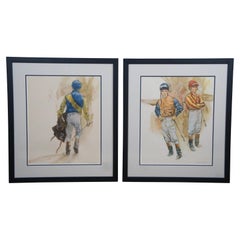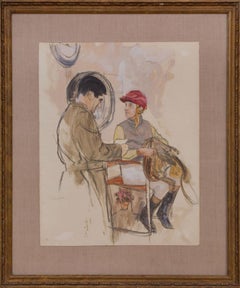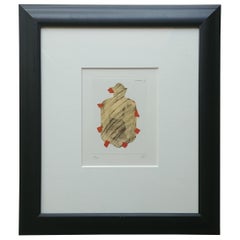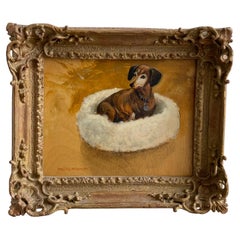Henry Koehler Art
to
2
2
1
1
2 Vintage Henry Koehler Signed Offset Lithographs Equestrian Jockey Horse Racing
By Henry Koehler
Located in Dayton, OH
Haggin & Olin Silks"" & ""Michael Phipps Silks"" by Henry Koehler
a pair of signed limited edition offset lithograph after the original painting by Henry Koehler. (American, b. 19...
Category
Late 20th Century American Classical Henry Koehler Art
Materials
Paper
"The Jockey Scale" Watercolor by Henry Koehler (1927-2019)
By Henry Koehler
Located in Bristol, CT
Watercolor and gouache on paper, signed 'Henry Koehler' lower left.
Provenance: Princess Fredericka Ann Guirey, Lyford Cay, Nassau
Art Sz: 23"H x 18"W
Frame Sz: 32"H x 28"W
Category
Mid-20th Century Henry Koehler Art
Materials
Watercolor
Related Items
The Abduction of the Sabine Women , a Renaissance drawing by Biagio Pupini
Located in PARIS, FR
This vigorous drawing has long been attributed to Polidoro da Caravaggio: The Abduction of the Sabine Women is one of the scenes that Polidoro depicted between 1525 and 1527 on the façade of the Milesi Palazzo in Rome. However, the proximity to another drawing inspired by this same façade, kept at the Ecole des Beaux-Arts, and to other drawings inspired by Polidoro kept at the Musée du Louvre, leads us to propose an attribution to Biagio Pupini, a Bolognese artist whose life remains barely known, despite the abundant number of drawings attributed to him.
1. Biagio Pupini, a Bolognese artist in the light of the Roman Renaissance
The early life of Biagio Pupini, an important figure of the first half of the Cinquecento in Bologna - Vasari mentions him several times - is still poorly known. Neither his date of birth (probably around 1490-1495) nor his training are known. He is said to have been a pupil of Francesco Francia (1450 - 1517) and his name appears for the first time in 1511 in a contract with the painter Bagnacavallo (c. 1484 - 1542) for the frescoes of a church in Faenza. He then collaborated with Girolamo da Carpi, at San Michele in Bosco and at the villa of Belriguardo.
He must have gone to Rome for the first time with Bagnacavallo between 1511 and 1519. There he discovered the art of Raphael, with whom he might have worked, and that of Polidoro da Caravaggio. This first visit, and those that followed, were the occasion for an intense study of ancient and modern art, as illustrated by his abundant graphic production.
Polidoro da Caravaggio had a particular influence on the technique adopted by Pupini. Executed on coloured paper, his drawings generally combine pen, brown ink and wash with abundant highlights of white gouache, as in the drawing presented here.
2. The Abduction of the Sabine Women
Our drawing is an adaptation of a fresco painted between 1525 and 1527 by Polidoro da Caravaggio on the façade of the Milesi Palace in Rome. These painted façades were very famous from the moment they were painted and inspired many artists during their stay in Rome. These frescoes are now very deteriorated and difficult to see, as the palace is in a rather narrow street.
The episode of the abduction of the Sabine women (which appears in the centre of the photo above) is a historical theme that goes back to the origins of Rome and is recounted both by Titus Livius (Ab Urbe condita I,13), by Ovid (Fasti III, 199-228) and by Plutarch (II, Romulus 14-19). After killing his twin brother Romus, Romulus populates the city of Rome by opening it up to refugees and brigands and finds himself with an excess of men. Because of their reputation, none of the inhabitants of the neighbouring cities want to give them their daughters in marriage. The Romans then decide to invite their Sabine neighbours to a great feast during which they slaughter the Sabines and kidnap their daughters.
The engraving made by Giovanni Battista Gallestruzzi (1618 - 1677) around 1656-1658 gives us a good understanding of the Polidoro fresco, allowing us to see how Biagio Pupini reworked the scene to extract this dynamic group.
With a remarkable economy of means, Biagio Pupini takes over the left-hand side of the fresco and depicts in a very dense space two main groups, each consisting of a Roman and a Sabine, completed by a group of three soldiers in the background (which seems to differ quite significantly from Polidoro's composition).
The balance of the drawing is based on a very strongly structured composition. The drawing is organised around a median vertical axis, which runs along both the elbow of the kidnapped Sabine on the left and the foot of her captor, and the two main diagonals, reinforced by four secondary diagonals. This diamond-shaped structure creates an extremely dynamic space, in which centripetal movements (the legs of the Sabine on the right, the arm of the soldier on the back at the top right) and centrifugal movements (the arm of the kidnapper on the left and the legs of the Sabine he is carrying away, the arm of the Sabine on the right) oppose each other, giving the drawing the appearance of a whirlpool around a central point of support situated slightly to the left of the navel of the kidnapper on the right.
3. Polidoro da Caravaggio, and the decorations of Roman palaces
Polidoro da Caravaggio was a paradoxical artist who entered Raphael's (1483 - 1520) workshop at a very young age, when he oversaw the Lodges in the Vatican. Most of his Roman work, which was the peak of his career, has disappeared, as he specialised in facade painting, and yet these paintings, which are eminently visible in urban spaces, have influenced generations of artists who copied them abundantly during their visits to Rome.
Polidoro Caldara was born in Caravaggio around 1495-1500 (the birthplace of Michelangelo Merisi, known as Caravaggio, who was born there in 1571), some forty kilometres east of Milan. According to Vasari, he arrived as a mason on the Vatican's construction site and joined Raphael's workshop around 1517 (at the age of eighteen according to Vasari). This integration would have allowed Polidoro to work not only on the frescoes of the Lodges, but also on some of the frescoes of the Chambers, as well as on the flat of Cardinal Bibiena in the Vatican.
After Raphael's death in 1520, Polidoro worked first with Perin del Vaga before joining forces with Maturino of Florence (1490 - 1528), whom he had also known in Raphael's workshop. Together they specialised in the painting of palace façades. They were to produce some forty façades decorated with grisaille paintings imitating antique bas-reliefs.
The Sack of Rome in 1527, during which his friend Maturino was killed, led Polidoro to flee first to Naples (where he had already stayed in 1523), then to Messina. It was while he was preparing his return to the peninsula that he was murdered by one of his assistants, Tonno Calabrese, in 1543.
In his Vite, Vasari celebrated Polidoro as the greatest façade decorator of his time, noting that "there is no flat, palace, garden or villa in Rome that does not contain a work by Polidoro". Polidoro's facade decorations, most of which have disappeared as they were displayed in the open air, constitute the most important lost chapter of Roman art of the Cinquecento. The few surviving drawings of the painter can, however, give an idea of the original appearance of his murals and show that he was an artist of remarkable and highly original genius.
4. The façade of the Milesi Palace
Giovanni Antonio Milesi, who commissioned this palace, located not far from the Tiber, north of Piazza Navona, was a native of the Bergamo area, like Polidoro, with whom he maintained close friendly ties. Executed in the last years before the Sack of Rome, around 1526-1527, the decoration of Palazzo Milesi is considered Polidoro's greatest decorative success.
An engraving by Ernesto Maccari made at the end of the nineteenth century allows us to understand the general balance of this façade, which was still well preserved at the time. The frescoes were not entirely monochrome, but alternated elements in chiaroscuro simulating marble bas-reliefs and those in ochre simulating bronze and gold vases...
Category
16th Century Old Masters Henry Koehler Art
Materials
Ink, Gouache, Pen
Claes Oldenburg Lithograph, Pop Art, Hot Water Bottle, Pencil, Numbered, Signed
By Claes Oldenburg
Located in Los Angeles, CA
Great Pop Art lithograph by the well known artist Claes Oldenburg ,pencil signed LR, numbered 26/100. Titeled on plate London 66(.image size along is 7.5 X 5.5 inches.) Framed.
Category
1960s British Modern Vintage Henry Koehler Art
Materials
Paper
H 17.25 in W 15 in D 1 in
Lee Hurst (3/4 Figure, Hands Together), Mixed media on Pergamenata parchment
By Howard Tangye
Located in London, GB
Howard Tangye (b.1948, Australia) has been an influential force in fashion for decades. Lecturing at London’s Central Saint Martins for 35 years, including 16 years as head of BA Wom...
Category
2010s Contemporary Henry Koehler Art
Materials
Paint, Paper, Parchment Paper, Charcoal, Crayon, Oil Crayon, Oil Pastel,...
"in Full Cry" English Equestrian Hunt Scene by Henry Alken Framed under Glass
By Henry Alken
Located in Morristown, NJ
Henry Thomas Alken (1785-1854) artist, a fox hunting lithograph: "In Full Cry Yoi Forward". Engraved by F. C. Lewis. Published by Tregear & Co. 90 C...
Category
19th Century English Georgian Antique Henry Koehler Art
Materials
Glass, Wood, Paper
H 28 in W 33.5 in D 1 in
Freya (Seated Backwards), Mixed media on grey board
By Howard Tangye
Located in London, GB
Howard Tangye (b.1948, Australia) has been an influential force in fashion for decades. Lecturing at London’s Central Saint Martins for 35 years, including 16 years as head of BA Wom...
Category
2010s Contemporary Henry Koehler Art
Materials
Other Medium, Archival Paper, Handmade Paper, Pen, Felt Pen, Permanent M...
Gustav Melcher ( German, 1898 -?) Boats off Venice Italy Ink Water Color c. 1918
By Gustav Melcher
Located in Meinisberg, CH
Gustav Melcher
(German, 1898-?)
Segelschiffe vor Venedig - Sailing ships off Venice
• India ink, water colour wash
• Visible image ca. 11.5 x 18 cm
• Glased Frame ca. 20 x 25 cm
• Verso various inscriptions
• Signed lower right
Gustav Melcher was a German painter and a pioneer in film, film criticism and film theory and created this clever little picture of the skyline of Venice with various vessels.
Going by the various inscriptions an the backing paper, this drawing was made in 1918 when Gustav was twenty years old and passed on three years later to Gertrud Melcher on the 1. 2. 1921. I have no reasons to doubt this information. The small drawing is still in its unopened frame, so maybe there is more information to be discovered , however this will be the privilege of the next owner.
The picture also has retained its original antique frame – note that it has lost over the years various sections of the gesso decoration.
The very precisely executed drawing is most enjoyable to look at and doing so, remember you are looking through the eyes of a young man, who saw this foreign sea cape over a century ago.
Thank you for your interest and please note, that I offer free worldwide shipping on all my items.
Gustav Melcher began his studies at the Düsseldorfer Kunstakademie under Peter Janssen and Eduard von Gebhardt. Originaly he was interested in figurative and portrait painting, but after time he decided to pursue the depiction of land- and marinescapes. Durin his studies the young artist undertook trips to visit England, Scotland, Belgium and France and he joined the artist society Malkasten. It was in those days he would hold speeches to his colleges about this new invention called ‘Kintopp’ – Melcher was a great advocate of the moving pictures...
Category
1910s Naturalistic Henry Koehler Art
Materials
India Ink, Paper, Watercolor
Gustav MelcherGustav Melcher ( German, 1898 -?) Boats off Venice Italy Ink Water Color c. 1918, 1918
Free Shipping
H 7.88 in W 9.85 in D 0.79 in
‘Mid Winter Landscape’ signed Lithograph, by Jacques Deperthes C1970 France
Located in Trensacq, FR
‘Mid Winter Landscape’ Lithograph print by Jacques Deperthes C1970
A large, good quality, mid-century lithographic print, hand signed by the Artist.
In exc...
Category
1970s European Mid-Century Modern Vintage Henry Koehler Art
Materials
Metal
H 35.44 in W 27.76 in D 0.99 in
Lithograph by Patricia Govezensky of Two Woman Gilt Framed Signed
Located in Stamford, CT
Lithograph by Patricia Govezensky of Two Sophisticated Woman in a vibrant city setting. Gilt framed.
EXX.
Category
Late 20th Century Art Deco Henry Koehler Art
Materials
Paper
Jane Wooster Scott Offset Lithograph Disneyland
By Jane Wooster Scott
Located in Miami, FL
This artwork titled "Disney" is an original offset lithograph on wove paper by American artist Jane Wooster Scott, born 1933. It is hand signed and numbered in pencil by the artist.
It is beautifully presented in a custom frame, measures:
Very good vintage condition.
About the artist:
Jane Wooster Scott grew up in the Philadelphia area and moved West following her dream to be a movie star. She quickly learned that goal was not for her, but became the host of a talk show where she interviewed movie stars.
She photographs what she sees to recapture them later on canvas. However, few of her paintings are real, existing scenes. They are compositions drawn from her personal imagination. She has been exhibiting her work in Los Angeles and New York and most of her shows have completely sold out on opening night.
In the "Guinness Book of Records" as one of the most reproduced artists in America, Jane Wooster Scott began copying work by folk artists such as Grandma Moses and gradually evolved into her own style. A turning point for her career was a joint showing at the Ankrum Gallery in Los Angeles with her comedian friend, Jonathan Winters. It was mostly a business crowd, and she sold 40 paintings in an hour.
Her works hang in museums, in public buildings and private homes in Europe, Asia and South America as well as in the United States. She has become legendary for her exceptional scenes of America s celebrations and holidays,
Among her collectors are Aaron Spelling, Sylvester Stallone, Charles Bronson, Kenny Rogers, Farah Fawcett...
Category
Late 20th Century American Folk Art Henry Koehler Art
Materials
Paper, Wood, Paint
View of High Street Birmingham, 1810s Framed Lithograph Signed T. Hollins
Located in Atlanta, GA
A framed Georgian period lithograph titled "A View of High Street, Birmingham" from the early 19th century, signed T. Hollins. Born in England during the early years of the 19th cent...
Category
Early 19th Century English Georgian Antique Henry Koehler Art
Materials
Glass, Paper, Wood
H 32.75 in W 41.25 in D 2 in
Antique Lithograph of an Arabian Horse
Located in Langweer, NL
Antique print titled 'Cheval Arabe'. Lithograph of an Arabian horse. This print originates from Dictionnaire Universel (..)'. Published circa 1850.
Category
Mid-19th Century Antique Henry Koehler Art
Materials
Paper
Jean Lurcat Lithograph signed Butterfly French Midcentury
By Jean Lurçat
Located in Mimizan, FR
Lithograph by Jean Lurcat signed by the artist
Butterfly French midcentury, circa 1930-1950
Good condition for its age having been framed the old order for the frame size is written ...
Category
1930s French Mid-Century Modern Vintage Henry Koehler Art
Materials
Paper
Previously Available Items
Dachshund, Oil on Board, Henry Koehler
By Henry Koehler
Located in Doylestown, PA
Henry Koehler (1927-2018), Dachshund, Oil on board, 2001, “Penny’s Fluffy Bed,” signed Henry Koehler lower left, titled and dated on the reverse. Measures: ...
Category
21st Century and Contemporary American Henry Koehler Art
Materials
Paint
RED JOCKEY BELOW Signed Lithograph, Jockey Silks, Horse Racing, Beige Yellow
By Henry Koehler
Located in Union City, NJ
RED JOCKEY BELOW is an original, hand drawn, limited edition lithograph by the well known sporting artist Henry Koehler, American (1927 - 2016). Printed using hand lithography techniques on archival Arches paper, 100% acid free. RED JOCKEY BELOW is an artistic, slightly birds-eye view of professional horse jockey on his horse, sporting a red racing silk...
Category
1970s Realist Henry Koehler Art
Materials
Lithograph
CONSTELLATION BELOW Signed Lithograph, Sailing, Cutter (boat), Nautical Art
By Henry Koehler
Located in Union City, NJ
CONSTELLTION BELOW is an original hand drawn limited edition lithograph by the well known sporting artist Henry Koehler, American (1927 - 2016). Printed using hand lithography techni...
Category
1970s Realist Henry Koehler Art
Materials
Lithograph
H 24 in W 35 in D 0.125 in
Race Day, Signed Lithograph, Horse Racing
By Henry Koehler
Located in Union City, NJ
Race Day is an original hand drawn limited edition lithograph by the well known sporting artist Henry Koehler, American (1927 - 2016). Printed using hand lith...
Category
1970s Realist Henry Koehler Art
Materials
Lithograph
Untitled (Horse Race, Edition 15/125)
By Henry Koehler
Located in New York, NY
Henry Koehler, (American 1927 - 2016) "Untitled: Horse Race" Edition 15/125, Abstract Lithograph signed and numbered in pencil, 22.50 x 30, Late 20th Century
Colors: Brown, Red, Pur...
Category
Late 20th Century Abstract Henry Koehler Art
Materials
Lithograph
Henry Koehler art for sale on 1stDibs.
Find a wide variety of authentic Henry Koehler art available for sale on 1stDibs. You can also browse by medium to find art by Henry Koehler in paint, canvas, charcoal and more. Not every interior allows for large Henry Koehler art, so small editions measuring 15 inches across are available. Customers who are interested in this artist might also find the work of MABEL ROLLINS HARRIS, Florence E. Nosworthy, and Marc Swanson. Henry Koehler art prices can differ depending upon medium, time period and other attributes. On 1stDibs, the price for these items starts at $3,300 and tops out at $13,750, while the average work can sell for $3,500.





